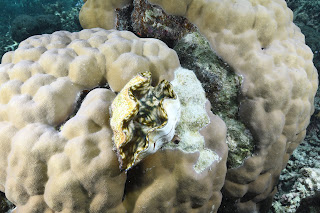Bench work.
Believe it or not, I love bench work. That term refers to all the tasks that must be completed at a lab bench - microscopy, molecular biology, measuring concentrations, weighing things, and the list goes on. The past few weeks, I've been standing at my lab bench at least half the day to extract DNA from Porites lobata.
 |
| PLOB (with a clam in the foreground). Photo by Kharis Schrage. |
I've gotten pretty good at extracting DNA from Porites lobata the past few years. My collaborator, Sarah, calls my methodology "clutch" because the DNA comes out so clean. It's a lot of monotony, but some days, it's calming to just stand at my lab bench an run extraction after extraction. Doing hands-on science is one thing I love about working at WHOI.
Our current goal is to extract DNA from all the corals we used in our nubbin transplant experiment. When we started the experiment last November, we chose colonies blindly, not knowing who was who. Once I get all the DNA ready to go, we can run a set of samples through a sequencing technique called 2bRAD and determine what lineage each of them belongs to. A lineage is kind of like a family - they're all genetically related to one another, and each lineage has a different ability to tolerate heat. When we go back to Palau this fall, we will count how many nubbins from each lineage lived or died. I hypothesize that the nubbins from the most heat-tolerant lineage will have the highest survival, but remember, we transplanted some nubbins away from their home site. Maybe there's some environmental condition like light that stresses out the heat-tolerant corals at the other sites. We will just have to see!
In the meantime, I'm enjoying my bench work. Life is good.
Comments
Post a Comment